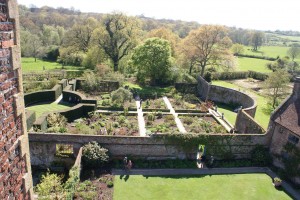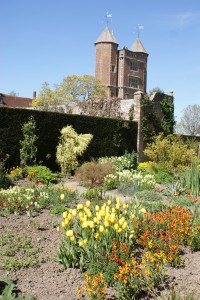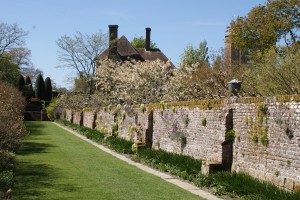
We had the enormous pleasure of a spring day at Sissinghurst Castle Gardens, the six acres of superbly beautiful English garden deep in the Weald of Kent, complete with mellow red brick and oast houses. It’s a celebration of nature as perfect as any botanical garden.
Whatever the structure of their curious marriage, Vita Sackville-West and Harold Nicolson collaborated perfectly on the Sissinghurst gardens, Harold working with ‘bits of paper and rulers’ to create the garden’s design, or in today’s inflated language its architecture, while Vita got to work on the actual planting, and continued to work in the garden – as well as writing a gardening column and numerous books from her study in the castle tower – for the rest of her life.

Harold by no means always agreed with Vita on the planting – but being Vita, and on the ground, she generally got her way with that – but they completely agreed on the contradictory principle of the garden, ‘the strictest formality of design with the maximum informality in planting’. This can be seen to be the reason why the gardens seem so fresh, and so English, today. The lines of the garden are razor sharp: crisp hedges, straight or circular paths, walls, arches, there is no ambiguity about the formality of Sissinghurst’s design. But Vita’s blazing colours and wealth of flower forms riot joyfully, insistently, triumphantly in and out of Harold’s ruled lines.
Here in Britain we are by now very familiar with the idea of wildness and rebellion in gardens; Lord Burlington introduced the daring approach by bringing William Kent back from ten years of study in Italy – along with knowledge of strictly formal Palladian architecture – to make Chiswick House and its gardens something for everyone to envy. To appreciate how revolutionary this was, think of a traditional French garden like Villandry, all stiff little hedges and formally planted flowers. Gardens used to be places of order and control, with wild nature outside the castle grounds. England was different: by the eighteenth century, the home counties were visibly tame, all straight hedges, parklike Oaks and Elms dotted about, and short well-controlled grass for the peacefully grazing animals. If the countryside looked like a park, then the aristocrat’s garden needed to look like a wilderness, and William Kent’s ingenious ‘river’ – complete with bridge and waterfall – along with Chiswick park’s bushy woods and wild-seeming vistas, gave just the right impression of rampant nature.

Sissinghurst does something different. Outside the garden, the Kentish woods are properly wild, if coppiced for centuries, so the garden has no need to pretend to be a wilderness. Instead, it celebrates the interplay of the natural and the man-made; there are vistas with brick walls and regular buttresses; cottages; the castle tower; pleached lime trees; paths and ‘doors’ between what Gertrude Jekyll called garden ‘rooms’. But in and around this structure, Vita’s plants climb the walls, draggle down them, or burst out above them in every shape and colour. Each view is carefully contrived, but a surprise for each visitor, fresh on each spring day, glowing with blossom, healthy with new leaf. As Harold Nicolson said, they had created a work of art. With nature, of course.
